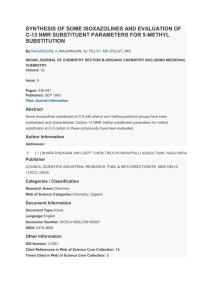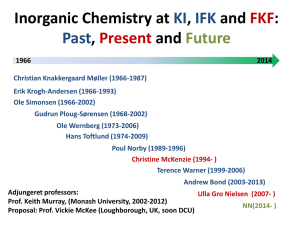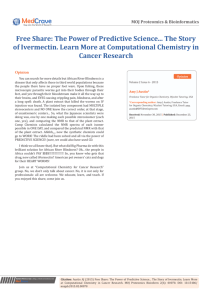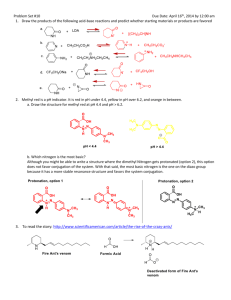Here is the Original File - University of New Hampshire
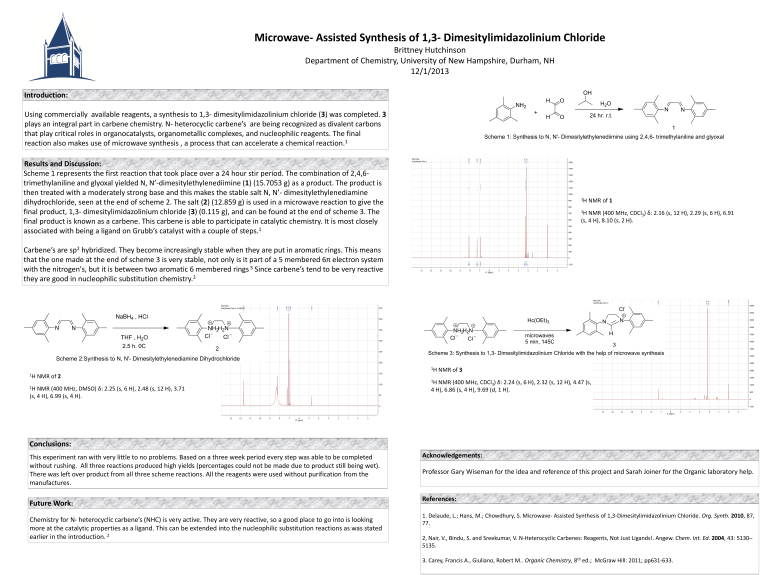
Microwave- Assisted Synthesis of 1,3- Dimesitylimidazolinium Chloride
Brittney Hutchinson
Department of Chemistry, University of New Hampshire, Durham, NH
12/1/2013
Introduction:
Using commercially available reagents, a synthesis to 1,3- dimesitylimidazolinium chloride (3) was completed. 3 plays an integral part in carbene chemistry. N- heterocyclic carbene’s are being recognized as divalent carbons that play critical roles in organocatalysts, organometallic complexes, and nucleophilic reagents. The final reaction also makes use of microwave synthesis , a process that can accelerate a chemical reaction.
1
Results and Discussion:
Scheme 1 represents the first reaction that took place over a 24 hour stir period. The combination of 2,4,6trimethylaniline and glyoxal yielded N, N’-dimesitylethylenediimine (1) (15.7053 g) as a product. The product is then treated with a moderately strong base and this makes the stable salt N, N’- dimesitylethylenediamine dihydrochloride, seen at the end of scheme 2. The salt (2) (12.859 g) is used in a microwave reaction to give the final product, 1,3- dimesitylimidazolinium chloride (3) (0.115 g), and can be found at the end of scheme 3. The final product is known as a carbene. This carbene is able to participate in catalytic chemistry. It is most closely associated with being a ligand on Grubb’s catalyst with a couple of steps.
1
Carbene’s are sp 2 hybridized. They become increasingly stable when they are put in aromatic rings. This means that the one made at the end of scheme 3 is very stable, not only is it part of a 5 membered 6π electron system with the nitrogen's, but it is between two aromatic 6 membered rings 3 Since carbene’s tend to be very reactive they are good in nucleophilic substitution chemistry.
2
1 H NMR of 1
1 H NMR (400 MHz, CDCl
3
) δ: 2.16 (s, 12 H), 2.29 (s, 6 H), 6.91
(s, 4 H), 8.10 (s, 2 H).
1 H NMR of 2
1 H NMR (400 MHz, DMSO) δ: 2.25 (s, 6 H), 2.48 (s, 12 H), 3.71
(s, 4 H), 6.99 (s, 4 H).
1 H NMR of 3
1 H NMR (400 MHz, CDCl
3
) δ: 2.24 (s, 6 H), 2.32 (s, 12 H), 4.47 (s,
4 H), 6.86 (s, 4 H), 9.69 (d, 1 H).
Conclusions:
This experiment ran with very little to no problems. Based on a three week period every step was able to be completed without rushing. All three reactions produced high yields (percentages could not be made due to product still being wet).
There was left over product from all three scheme reactions. All the reagents were used without purification from the manufactures.
Future Work :
Chemistry for N- heterocyclic carbene’s (NHC) is very active. They are very reactive, so a good place to go into is looking more at the catalytic properties as a ligand. This can be extended into the nucleophilic substitution reactions as was stated earlier in the introduction.
2
Acknowledgements:
Professor Gary Wiseman for the idea and reference of this project and Sarah Joiner for the Organic laboratory help.
References:
1. Delaude, L.; Hans, M.; Chowdhury, S. Microwave- Assisted Synthesis of 1,3-Dimesitylimidazolinium Chloride. Org. Synth. 2010, 87,
77.
2, Nair, V., Bindu, S. and Sreekumar, V. N-Heterocyclic Carbenes: Reagents, Not Just Ligands!. Angew. Chem. Int. Ed. 2004, 43: 5130–
5135.
3. Carey, Francis A., Giuliano, Robert M.. Organic Chemistry, 8 th ed.; McGraw Hill: 2011; pp631-633.

